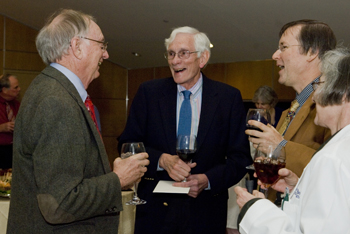
James Snell, M.D., second from left, shares a laugh with Bob Cotton, M.D., left, William Dupont, Ph.D., and Geraldine Miller, M.D., during Snell's retirement reception on Tuesday. (photo by Dana Johnson)
Snell’s half-century of service to Vanderbilt honored
After 50 years with Vanderbilt's division of Allergy, Pulmonary and Critical Care Medicine, James Snell, M.D., is undoubtedly an expert on the division. When he retires this month, he plans to write a book chronicling the rise of the division.
“There is a lot of history, and I thought it ought to be recorded,” Snell said. “Its origins go way back to the beginning of the Vanderbilt Medical School.”
One of the three original specialty clinics was a chest clinic, Snell said, because tuberculosis was the pulmonary problem of the era. Because Tennessee was a high-incidence state, Vanderbilt designated a special set of tuberculosis beds, which were still in place when Snell arrived for medical school in 1954.
Snell graduated from the School of Medicine in 1958, and aside from a brief detour to The New York Hospital for a fellowship in clinical pulmonary disease, he came to Vanderbilt and stayed.
“Jim Snell has been a pillar of strength and probity for Vanderbilt. Even as green, naive medical students, we recognized that his care and consideration for patients and for teaching stood out,” said James Sheller, M.D., professor of Medicine in the Division of Allergy, Pulmonary and Critical Care Medicine.
Snell was chief of the division and director of Ambulatory Care Programs. He was vice chair of the Department of Medicine, and, finally, VMC's Corporate Compliance Officer. He also oversaw the move to The Vanderbilt Clinic when it opened in 1988.
One of Snell's greatest impacts was revamping pulmonary teaching in the early 1970s. VMC was one of four institutions awarded a National Institutes of Health grant to stimulate programs in hopes of addressing the national shortage of pulmonary physicians. Since then, Snell said, the growth has been exponential.
“I was able to make the initial investment and stimulus that allowed our pulmonary program to take off. Vanderbilt moved to the leading edge of clinical care for lung diseases,” Snell said.
“We had an impact nationally just from our own medical school graduates as they went on to residencies and fellowships at other institutions.”
Snell published one of the first papers on the pulmonary vascular effects of endotoxin, and he introduced flexible fiber optic bronchoscopy and transbronchial lung biopsy. He organized the first Vanderbilt 24/7 consult service, which led to the organization of the Medical Intensive Care Unit, for which he was appointed medical director.
Snell was also committed to public service, including serving as president of the American Lung Association of Tennessee.
Snell said one of the beauties of his half-century career was the freedom VMC provided to participate in this broad range of activities.
“I was able to work with medical students, residents and fellows, other faculty and the public at large. I was able to pretty well do what I wanted to do, and the institution has been relentlessly supportive of the various directions I've taken,” he said.
Harry Jacobson, M.D., vice chancellor for Health Affairs, said most have not heard about Snell's accomplishments because he is two things above all else: quiet and modest.
“He is both a skilled administrator and a revered clinician who has earned the respect and love of his patients,” Jacobson said. “We at Vanderbilt Medical Center are forever grateful that Jim Snell came our way.”













